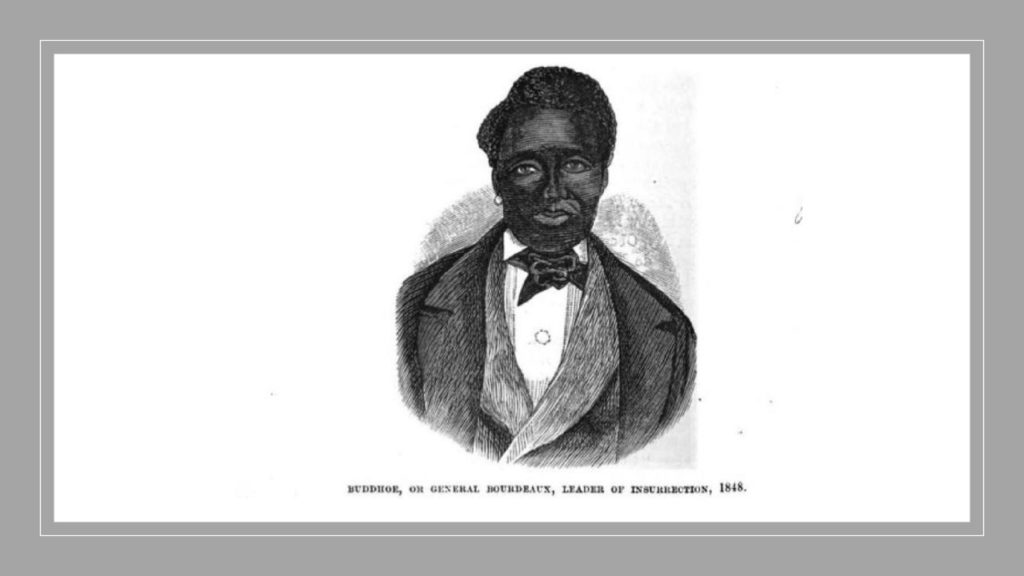
Editor’s Note: Researcher and historian Deirdre Calley presented this paper about General Buddhoe’s time in New York City after his exile from St. Croix at an event hosted by the Society of Virgin Islands Historians in February. It is reprinted here with their permission.
What happened to John Guttliff Bordeaux — widely known as General Buddhoe — after he freed the enslaved in 1848 and was exiled from St. Croix?
According to William Cissel, a former National Park Service historian, after the slaves were liberated, Buddhoe was jailed for about six months and then exiled to Trinidad. Buddhoe was told if he ever returned to the Danish West Indies, he would be executed. Cissel said there are stories of Buddhoe being robbed and forced to work on the ship and some historians argue that he was taken to Trinidad without incident and later left for the United States. Some say he died in Grenada.
I have found digitized census and police records as well as historic newspaper articles which not only provide support for all that William Cissel said, but also have enabled me to piece together a timeline of John Bordeaux’s residence in New York City, his probable departure from New York City, and shed light on his motivations for leaving New York City.
These sources show that he was a hard-working, resourceful family man, with strong moral values, who people looked up to. Even his enemies are said to have looked after him to ensure his well-being.
The picture of John Bordeaux was found in Edwin Taylor’s “Leaflets from the Danish West Indies: Descriptive of the Social, Political, and Commercial Condition of these Islands,” printed by Wm. Dawson and Sons, London 1888.
To start, I will briefly recap what is known of John Guttliff Bordeaux’s life. According to the St. John Historical Society web page, General Buddhoe was John Gottliff Bordeaux. He was born enslaved on March 19, 1820, at Estate La Grange. His father’s identity has not been ascertained. His mother was Maria Rosina, who had been born enslaved on La Grange plantation in 1799.
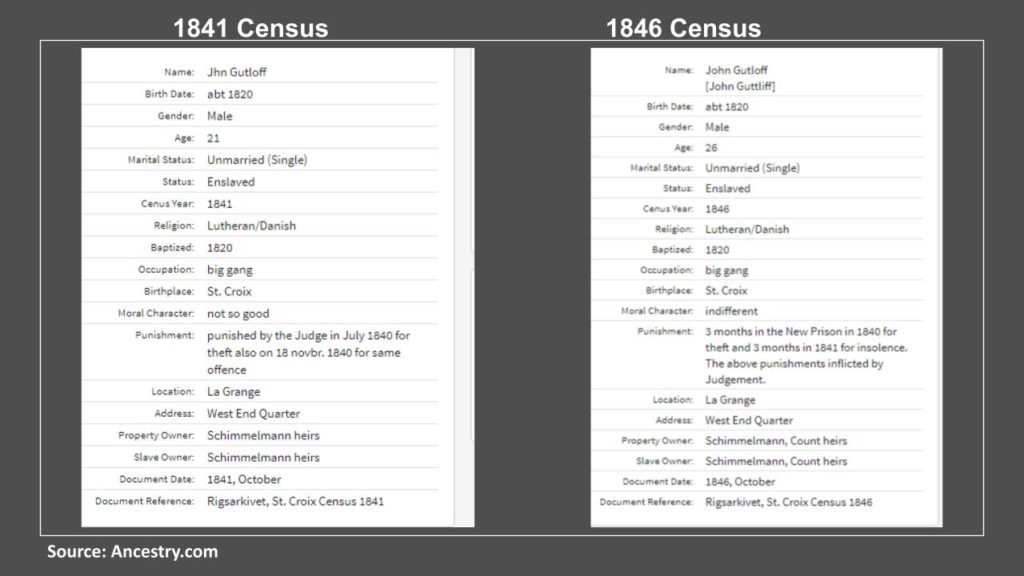
John Gottliff appears in the censuses of 1841 and 1846 as belonging to the Lutheran Church and a member of the big gang. His character was described as “not too good” in 1841 and as “indifferent” in 1846. He was imprisoned for three months in 1840 for theft and for three months in 1841 for “insolence.”
While searching online I translated a document from Mich Vraa’s 2017 book entitled, “Peters Kerlighed.” It was a police report from Frederiksted on April 12, 1842, written by Police Commissioner E. Didrichsen. To summarize, John Gottlieb Bordeaux was charged for the theft of food from the storehouse at the plantation La Grange, Frederiksted. When questioned, he explained that he felt obliged to bring food to the mill La Grange, because an older slave who worked there was his father and had been linked to the base of the mill’s sugar press since he frequently had tried to escape and could not get his own food. The manager Ramsay recognized that the old slave was very confused and may not always have had the same to eat like the others. Thus, it appears that he was imprisoned for stealing to feed his family.
On July 3, 1848, John Bordeaux was a leader in the freedom revolt. He was averse to the shedding of blood and saved the life of Major Gyllich, who stayed in prison with Bordeaux to ensure his safety. He was instrumental in not only obtaining freedom for the enslaved but also maintaining peace, stopping rioting and pillaging and trying to ensure that no lives were lost.[1] In the end, General Buddhoe was imprisoned for his participation in the freedom revolt and eventually banished from St. Croix. It was written that he had to be forcibly abducted from the West End since the people did not want him to be put in jail.[2] He was about 27 years old when this occurred.
In Thorkild Hansen’s book, “Islands of Slaves,” he writes that on Dec. 15, 1848, after being jailed for approximately six months, General Buddhoe was on the ship Ornen under Capt. Irminger’s command. He states that the captain interrogated General Buddhoe daily to find out who was behind the revolt, how long it had been planned and how much [Governor General] Peter Von Scholten knew. The interrogations continued, with General Buddhoe remaining silent until Jan. 8, 1849, when the ship anchored at Port of Spain on Trinidad. It is written that he was told that he would endanger his life if he ever showed up in the Danish West Indies again.
The last document attesting to his whereabouts was an 1850 letter from Lewis Tappan, a leader on the Underground Railroad, who stated that Bordeaux was quite poor, in New York City and being assisted by his quondam [meaning sometime or former] enemy. This letter confirms that he did make it to the United States and settled in New York City. John Gottliff Bordeaux is referenced as being in New York City in the letter dated June 11, 1850, from Lewis Tappan to Mr. Scoble. Lewis Tappan refers to him as Gottlieb Bordeaux, Bordeaux and B. Lewis. Tappan states that he came to his office introduced by a man from his island who commanded troops in opposition to him during the revolt, that Bordeaux was quite poor and was being assisted by his quondam enemy.[3]
That is the last historically documented account of John Gutliff Bordeaux. I believe that the following primary sources provide a brief chronology of his time in New York City. These documents were found in digitized historic newspapers and censuses.
On May 27, 1852, the New York Daily Times writes that John Gutliff Bordeau was arrested for the attempted murder of Michael Dnundia/Inundia. He was sent to the Tombs/Jail while they awaited the results of the injuries.
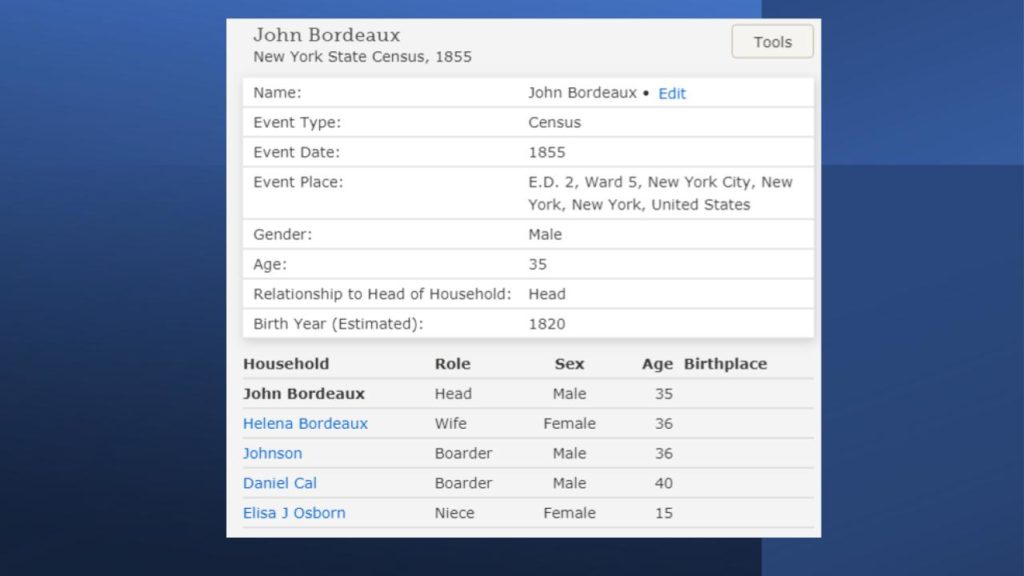
The charges appear to have been resolved because the 1855 New York State census details John Bordeaux as living in the fifth ward of New York City with his wife, Helena Bordeaux, two male borders and a niece, Elisa J. Osborne. The census reports him as being born in 1820, in the Caribbean and entering the United State five years prior to the census, or 1850, which correlates with the Lewis Tappan letter. He is listed as working in a shipping office.
In the following year, 1856, both the New York Daily Tribune and the New York Sun report that John Bordeaux, keeper of a boarding house at 9 Worth Street, was arrested for felonious assault on a John Dawson, one of his boarders. It was reported that the motive was jealousy.
In the next year, 1857 Ann Hopkins was murdered on Worth Street, the street where John Bordeaux was reported as being a boarding housekeeper. A man named John Dorsay was arrested, charged, found guilty and hanged for her murder. In the newspaper accounts of the Coroner’s Inquest and trial, Helena Burdoe/Eleanor Burdell testified that she was living with John Dorsay/Dawson/Dorsey at that time as his wife. An additional witness, Josephine Dixon, testified that John Dorsay was living with another man’s wife on the fourth floor of the building.
I believe that the John Dawson detailed previously in the assault charge, attributed to jealousy, is the same John Dorsay who was said to be living with a Helena Bordeaux, the wife of another man, and that John Bordeaux found out about his wife’s relationship with his boarder, John Dawson, in 1856 and a fight ensued. A year later, Helena Bordeaux was living with John Dorsey as his wife in the same housing complex. No court documents were found to provide additional details.
By 1858, Trow’s New York City Directory lists John Bordeaux as living in a boarding house at 58 Leonard Street, around the block from his prior residence on Worth Street. Hence, John Bordeaux was no longer living in the same housing complex where his wife was living with John Dorsey.
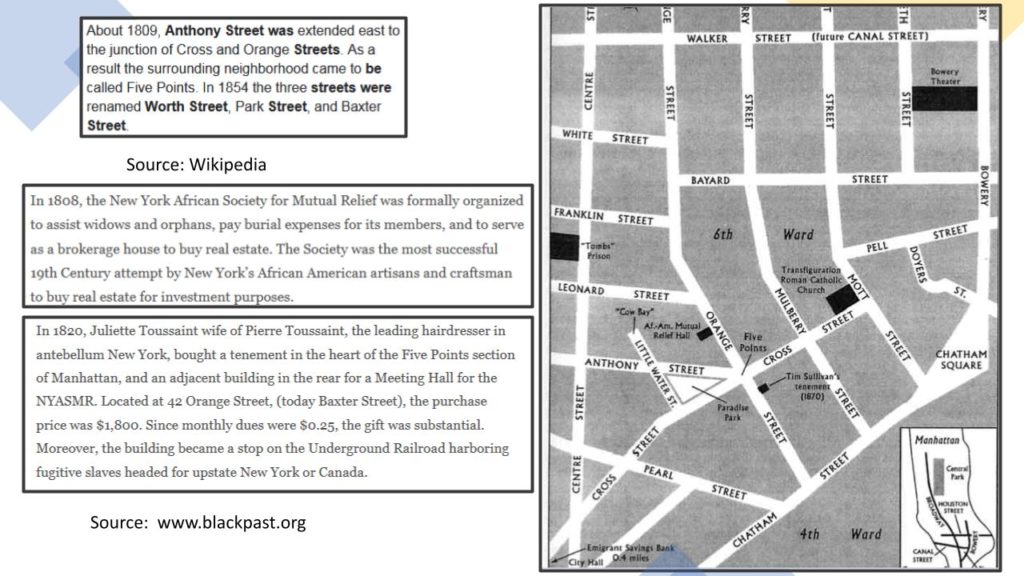
A map of the Five Points/West Tribeca Neighborhood where John Bordeaux lived may be dated to the time when he arrived in New York City, prior to 1854. The street named Anthony Street was later renamed Worth Street in 1854, according to Wikipedia. The map also shows Leonard Street as being one block north of Anthony/Worth Street.
This map provides additional details on John Bordeaux’s time in New York City. Just northeast of Anthony Street was the African American Mutual Relief Hall. According to blackpast.org, the hall was purchased in 1820 by Juliette Toussaint and not only carried out the mission of the African American Society for Mutual Relief but was also a stop on the Underground Railroad. Since Lewis Tappan was a leader on the Underground Railroad, he would have known of this hall and recommended that John Bordeaux go there for assistance. Lastly, northwest of Anthony and Leonard Street is the Tombs prison where the prior articles state that John Bordeaux was sent.
Thus, historical records detail that John Bordeaux did come to New York City around 1850. He found housing, employment and a wife. He was a hard-working, resourceful individual as he is recorded as working at a shipping office, being the keeper of a boarding house, and taking in boarders. He prioritized the well-being of his family as he was jailed for stealing to feed his father and took into his household a niece, of either him or his wife. His wife developed a relationship with John Dawson/Dorsay/Dorsey, a boarder in the same housing complex. She then began to live with John Dawson/Dorsay as his wife. John Bordeaux then moves around the block to the boarding house at 58 Leonard Street in 1858. No records are found of John Bordeaux after 1858. Hence, it appears that he left New York City.
Living in New York City at the time was difficult. Even though New York was a free state, slave catchers were all around attempting to kidnap free individuals and sell them into slavery. Add to that how hard it was to pay his bills since he held two jobs and took in boarders. Lastly, his wife left him and began to live with one of his boarders, in the same boarding house. These facts could be seen as providing sufficient motivation to leave New York City and try a new area. This gives credence to the statements that some say he eventually moved to and died in Grenada.
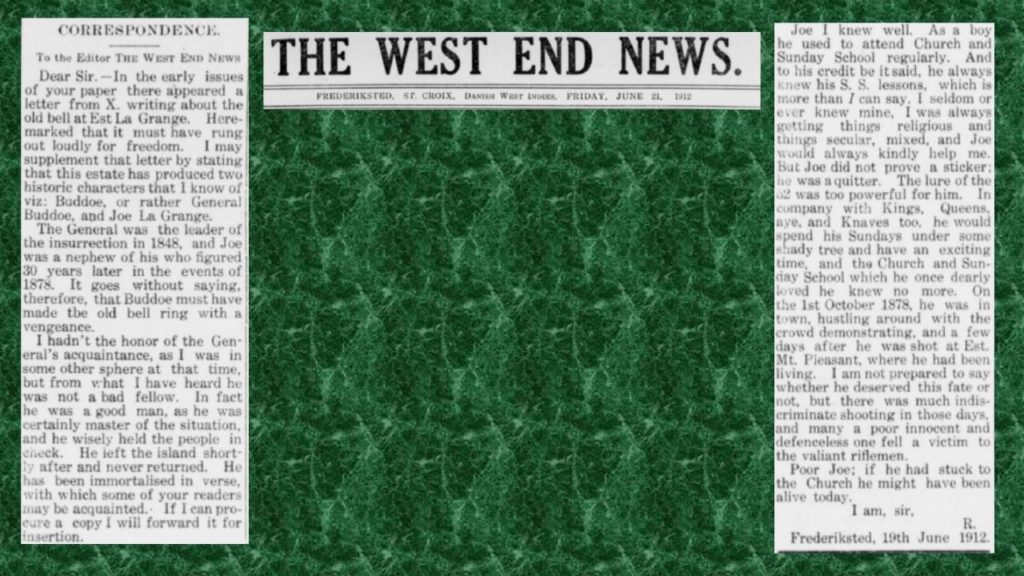
Historic newspapers attest to the fact that John Bordeaux was held in high esteem by the generations who came after him. In the June 21, 1912 edition of The West End News, someone named R wrote that Estate La Grange produced two historic figures, “General Buddoe and Joe La Grange.” He says that he never had the honor of meeting the General but heard that he was a good man. He says that Joe La Grange was General Buddoe’s nephew and that he was smart.
In the March 1938 edition of The National Geographic Magazine, there is a picture of Mary Prince, a maid at the Grand Hotel in Charlotte Amalie, U.S. Virgin Islands, who says with pride in her best dress and calico cap, that General Bordeaux was her great-great-uncle and that her third cousin was a leader in the 1878 revolt.
— Deirdre Calley is the Deputy Director with the Nassau County, New York Office of the Legislative Budget Review. She earned her master’s degree in economics from Boston University and a bachelor’s degree in economics and art history from the College of the Holy Cross. She has conducted historical research on the one-room schoolhouse in Hempstead, New York, and won a Certificate of Recognition from the incorporated village of Hempstead.
Footnotes:
[1] Tyson, George, “John Gottliff: The Man Behind Buddhoe”, St. John Historical Society, June 7, 2006.
[2] Taylor, Chas. Edwain, “Leaflets from the Danish West Indies”, Wm. Dawson and Sons, 1888.
[3] This letter was published in the Journal of Negro History, Volume 12, No. 3, July 1927, pages 413-436. and is available online at JSTOR.com.





